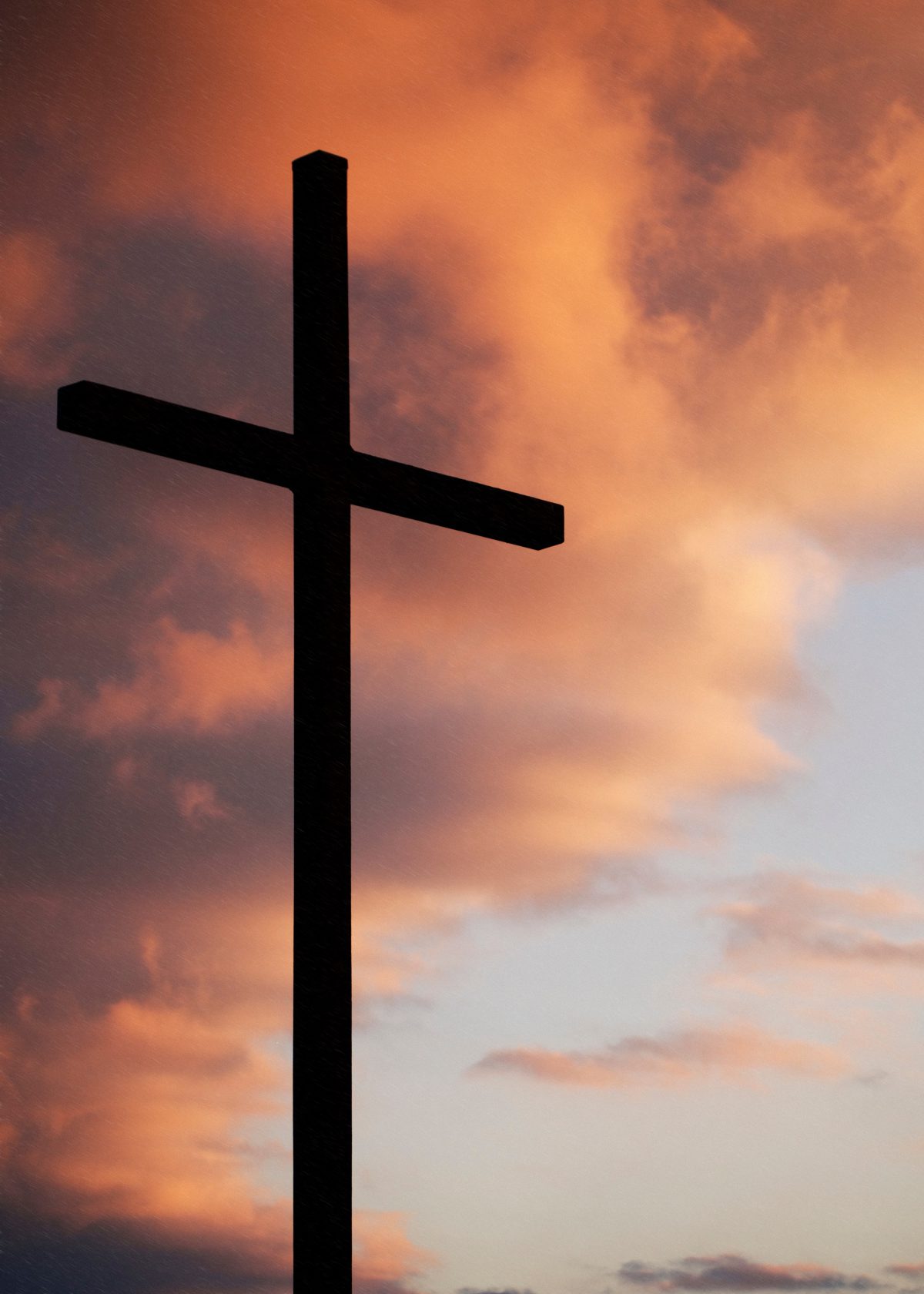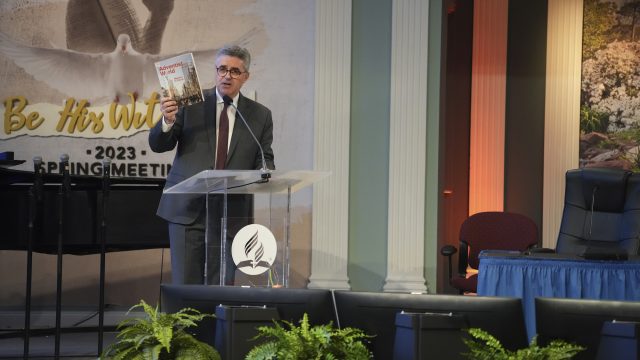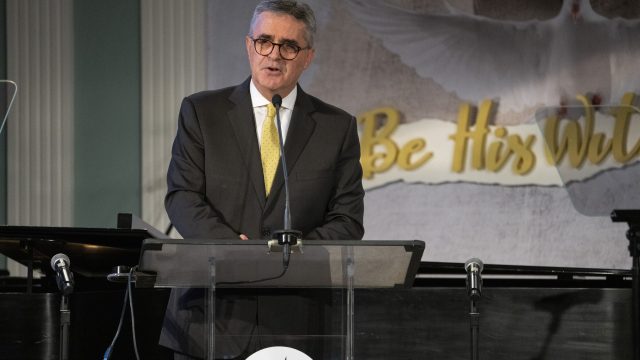I was driving to a Wednesday night prayer meeting in a lake-effect emboldened snowstorm when I noticed the figure of a man standing […]

I was driving to a Wednesday night prayer meeting in a lake-effect emboldened snowstorm when I noticed the figure of a man standing at the side of the road. As I drove past him, I was able to make out his liturgical vestments under a thick, black overcoat, his gloved hand clenching a white coffee cup.
Ash Wednesday Ritual
The sandwich-board sign beside him explained his mission. It was Ash Wednesday, and this local minister was offering “ashes to go” for those who were in a rush but still wanted to squeeze in the post-indulgence Lenten ritual.
It took me off guard. Somehow, I hadn’t connected the myriad advertisements for cholesterol-rich, jelly-filled pastries to Fat Tuesday and the beginning of Lent. Maybe it was just my Adventism. With few exceptions, Easter celebrations are not usually major events for Adventists.
Focus of Our Faith
No question: the Adventist faith centers on the death and resurrection of Christ. We value the atoning blood that was shed on Calvary’s cross as the only means by which we may be set free from the wages of sin and its power over us (Heb. 2:14, 15). We view the self-sacrificing love that was displayed on that cross as a universally resonant response to the dispute Satan originated so long ago concerning the nature of God’s character (Rom. 5:8).
In the resurrection and ascension, we find a Savior who conquers death and ascends to enter the heavenly sanctuary to serve as our high priest—humankind’s only mediator and intercessor—a right He purchased with His blood (verse 9; Gal. 1:4; 1 Tim. 2:6; Titus 2:14). And we anticipate the soon coming of this same Jesus in accordance with His promise to return in power and glory (John 14:1-3).
In the light of these solemn biblical emphases, we experience a certain level of discomfort with bunnies and Easter eggs that have more in common with pagan fertility rituals than the risen Lord. Beyond this, there is the ever-changing astronomical date for the celebration, which corresponds to the new moon after the spring equinox, as well as the sunrise service, which is not a standard feature of Adventist worship practice. Indeed, some have applied Ezekiel’s unflattering comments on sunrise worship to the Christian Easter ritual (see Eze. 8:15, 16).
Perhaps the greatest issue with current Christian Easter holiday practice is that it separates the death and resurrection of Jesus from the historical and prophetic context in which it was originally given.
Focus of Scripture
After His resurrection, Jesus drew near to two of His discouraged followers as they made their way to Emmaus. Though they walked that road in the glow of late afternoon, the sun had not yet risen on their hopes. They lamented the reality of the Messiah’s death, and, mercifully, Jesus took the opportunity to enlighten them. The Scriptures tell us that “beginning with Moses and all the Prophets, he interpreted to them in all the Scriptures the things concerning himself” (Luke 24:27, ESV).1
In forging a theology of the recent events—i.e., the prophetic significance of the convocations of Passover, Unleavened Bread, and First Fruits—Jesus defaulted back to Moses. God used Moses to establish the intricacies of the Old Testament sanctuary service. These services contained knowledge of the coming Sacrificial Lamb, the Sabbath rest when He would lie in the tomb, and His resurrection with power as the “firstfruits” of those who will come forth at His promised return (1 Cor. 15:20; Rev. 14:4).
This view of the Crucifixion and Resurrection presents that initial weekend of ceremonies as the commencement of seven convocations highlighting the redemptive work of Christ throughout the year. Found in Leviticus 23, these events begin with the provision of the lamb’s atoning blood and culminate with a celebratory people, cleansed and restored.
Contemporary celebration of Easter has divorced the death and resurrection of Christ from this prophetic time line that God gave through Moses. Instead of Passover as the beginning, Easter is the end. Many Christians begin their observance more than a month beforehand, indulging on Fat Tuesday, then beginning a fast on Ash Wednesday.
As Easter approaches, they observe Palm Sunday and Good Friday. After the conspicuously absent Sabbath of Christ’s rest in the tomb, Easter Sunday is celebrated with vigor. With that, the Paschal Season comes to a close. Sadly lacking is the significance of what Christ would do after His resurrection. In missing the weight of Moses in the interpretation of these events, many are still confused today.
Journalist Philip Yancey writes, “I have concluded . . . that the Ascension represents my greatest struggle of faith.” He posits the question: “Would it not have been better if the Ascension had never happened?”2 Certainly not for Jesus. And surely not for us, for whom Jesus has now entered into “a greater and more perfect tabernacle, not made with hands” (Heb. 9:11), in order to serve as the advocate for us, sinners He came to save. He Himself assures us that it is to our advantage that He should go away (John 16:7). Rather than be troubled by His ascension, we may take courage that He is preparing a place for us and that He will return to take us home with Him. Understanding the Mosaic sanctuary unlocks the mystery of Christ’s heavenly ministry before His promised return. And it is this reality to which Jesus pointed to buoy the saddened hearts of the discouraged disciples that Sunday afternoon along the road.
Conclusion
I don’t advocate a return to practicing all the yearly Mosaic convocations. We have no established temple or working priesthood. And even if these were still in place, the reinstitution of sacrificial ritual would serve only as a denial of the perfect sacrifice that Christ made for humanity. When Jesus breathed His last, the veil of the Temple was torn in two, and at that moment the sanctuary services became mere shadows in the light of the fulfillment that had come to pass.
What we may do is celebrate a week of evangelistic services that begin at the events of the triumphal entry, describe the Messiah’s work, trace the events of His betrayal, trial, crucifixion, and resurrection culminating with a Sunday sunset service to commemorate Jesus’ gracious ministry to discouraged disciples along the road and, later, in the upper room.
Tracing the footsteps of Jesus beyond the cross and on into the heavenly sanctuary will deepen our understanding of and appreciation for His earthly and now heavenly ministry; providing a fuller, richer gospel message, with its soon-coming climax, when Jesus returns a second time to take His people home to glory. Rather than ignore the holiday entirely, we should engage as Jesus engaged, seeking to bring clarity through the power of God’s Word and to begin as He began, by drawing upon the wisdom of Moses. n
1 Scripture quotations marked ESV are from The Holy Bible, English Standard Version, copyright © 2001 by Crossway Bibles, a division of Good News Publishers. Used by permission. All rights reserved.
2 Philip Yancey, The Jesus I Never Knew (1995), p. 229.
Jarod Thomas has served the Adventist church as a Bible instructor, chaplain, and pastor. He currently serves as Communications Manager for the General Conference Ministerial Association.








